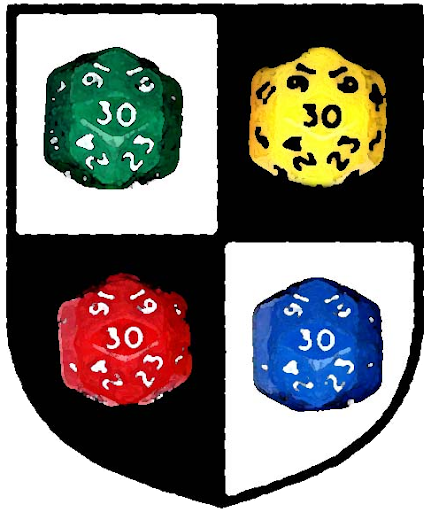
Adventures in Fantasy (1979)
1 hour ago
this area of the forest, becoming progressively
wilder and crazier and more dangerous.
 The 3rd edition of Swords & Wizardry: Whitebox is now available in soft and hardcover on Lulu (as well as the free, updated PDF).
The 3rd edition of Swords & Wizardry: Whitebox is now available in soft and hardcover on Lulu (as well as the free, updated PDF). I'd give you all real dice if I could, but these are the best I can manage. Click the thumbnail above to download. Open in GIMP or Photoshop and personalize beforehand if you like (there's another version here with circles around the numbers for better readability)... Construction instructions:
I'd give you all real dice if I could, but these are the best I can manage. Click the thumbnail above to download. Open in GIMP or Photoshop and personalize beforehand if you like (there's another version here with circles around the numbers for better readability)... Construction instructions: • Lightly score with razor on lines and where black flaps attach to die faces. Gently fold your new cut out model along these scored lines.
• Lightly score with razor on lines and where black flaps attach to die faces. Gently fold your new cut out model along these scored lines. • Glue larger black folds on either half first. Place small amount of glue on smaller black flaps. Take a deep breath and close the two halves of the die together, making sure the small flaps are tucked in and are each touching an adjacent edge. Hold for several seconds (exhale). Blow on completed die for a half minute to make sure it'll hold. Voila!
• Glue larger black folds on either half first. Place small amount of glue on smaller black flaps. Take a deep breath and close the two halves of the die together, making sure the small flaps are tucked in and are each touching an adjacent edge. Hold for several seconds (exhale). Blow on completed die for a half minute to make sure it'll hold. Voila! Rather festive I thought. But how would they hold up to those Gamescience dice to the left of 'em? In my quick, non-scientific 100 roll test, the variance was 26 again - same as the last time with my slightly larger prototype (Chessex was 24 and GS was 22). It was kind of fun to test with some eggnog and bourbon on the side. Happy Holidays everyone! Party on.
Rather festive I thought. But how would they hold up to those Gamescience dice to the left of 'em? In my quick, non-scientific 100 roll test, the variance was 26 again - same as the last time with my slightly larger prototype (Chessex was 24 and GS was 22). It was kind of fun to test with some eggnog and bourbon on the side. Happy Holidays everyone! Party on.
 Our video chat game was canceled tonight due to a player’s hard drive failure, so I had some time to goof around and made another paper die. I’d been thinking about how to make a d10 - definitely harder than my previous paper d8. I decided to make it a little larger than normal for ease of cutting and folding. It had to have 5 tabs to hold it together decently (the d8 only took 3) and I think the extra weight of these might have reduced its accuracy. It still did pretty well on a quick comparison test of 100 rolls:
Our video chat game was canceled tonight due to a player’s hard drive failure, so I had some time to goof around and made another paper die. I’d been thinking about how to make a d10 - definitely harder than my previous paper d8. I decided to make it a little larger than normal for ease of cutting and folding. It had to have 5 tabs to hold it together decently (the d8 only took 3) and I think the extra weight of these might have reduced its accuracy. It still did pretty well on a quick comparison test of 100 rolls: Incidentally, greetings visitors from Metafilter, I see there was some interest in a picture I linked to quite a while back of a Gelatinous Cube. You might keep an eye on this seller on eBay if you’re interested in one or two of your own - cheap too. A big thanks to Bliss Infinite for pointing them out, I picked up a couple before they sold out and they’re killer (pic below).
Incidentally, greetings visitors from Metafilter, I see there was some interest in a picture I linked to quite a while back of a Gelatinous Cube. You might keep an eye on this seller on eBay if you’re interested in one or two of your own - cheap too. A big thanks to Bliss Infinite for pointing them out, I picked up a couple before they sold out and they’re killer (pic below).
 The rest of the session involved their travel to the next town and fortress along the river, the great castle Beynac of Lord Beringer. They approached it at dusk after passing a guard station half way there. Both at the guard post and at Beynac itself there was some inspection of their belongings and tax collection which seriously irked Wagstaff in particular. Their funds are running seriously low again, and Wagstaff may find himself in the position of money lender to the rest of the party if things don’t improve soon. Approaching the inner bailey, they attempted to arrange an audience with Lord Beringer himself. The men-at-arms said that there might be a possibility in three weeks and to come back then. None of the party heard the snickering behind them as they took their leave.
The rest of the session involved their travel to the next town and fortress along the river, the great castle Beynac of Lord Beringer. They approached it at dusk after passing a guard station half way there. Both at the guard post and at Beynac itself there was some inspection of their belongings and tax collection which seriously irked Wagstaff in particular. Their funds are running seriously low again, and Wagstaff may find himself in the position of money lender to the rest of the party if things don’t improve soon. Approaching the inner bailey, they attempted to arrange an audience with Lord Beringer himself. The men-at-arms said that there might be a possibility in three weeks and to come back then. None of the party heard the snickering behind them as they took their leave.
 The Skunk Ape
The Skunk Ape
Armor Class: 6 [13]
Hit Dice: 3
Attacks: 2 hands (1d3), 1 bite (1d4)
Saving Throw: 13
Move: 12
CL/XP: 4/140
Special: 30’ radius odor causes -3 on opponents’ “to hit” rolls. Can hide in dense foliage and surprise on a 1-3.
 I'm still plodding away at these. All that's left is the Shrine of Evil Chaos, which is a bit larger and will probably have to take up one whole side of an index card. I've left out secret doors on all of these, and the missing secret door in the Gnoll Lair (area #50 leading to #63 in the Shrine area) is truly missed here. The idea of a previous adventurer, a thief, being found just inside the doorway in obvious hasty retreat is a nice touch, as would be finding his elven boots. In fact, all the secret doors missing in these dissections are missed to an extent - being able to run away from a group of monsters directly into the lair of another is just cool. I'm still glad to have chopped them up like this though. Our sessions are so short that it feels like they'll mesh well, and having them handy is a nice insurance policy against the party veering off at the last second from where I'd expected them to travel. As usual, click the image above to download or for a closer look.
I'm still plodding away at these. All that's left is the Shrine of Evil Chaos, which is a bit larger and will probably have to take up one whole side of an index card. I've left out secret doors on all of these, and the missing secret door in the Gnoll Lair (area #50 leading to #63 in the Shrine area) is truly missed here. The idea of a previous adventurer, a thief, being found just inside the doorway in obvious hasty retreat is a nice touch, as would be finding his elven boots. In fact, all the secret doors missing in these dissections are missed to an extent - being able to run away from a group of monsters directly into the lair of another is just cool. I'm still glad to have chopped them up like this though. Our sessions are so short that it feels like they'll mesh well, and having them handy is a nice insurance policy against the party veering off at the last second from where I'd expected them to travel. As usual, click the image above to download or for a closer look.
 Tracing lines of relief.
Tracing lines of relief. Elevating lines of relief.
Elevating lines of relief. Connecting lines of relief - drawing contours.
Connecting lines of relief - drawing contours. Another view.
Another view. Exploding the bottom map onto the created contours.
Exploding the bottom map onto the created contours. Continuing my chopping up of B2 into mini-adventures on index cards, here's the Shunned Cavern (area G) and the Caves of the Minotaur (area I) again formatted for ye olde 4x6's. Since these are especially small maps, I put two of them onto the same PDF. If you can use these or like the idea, you might also be interested in Fenway5's recent "Pocketful of Peril" posts. As usual, click the image above for a closer look or to download the PDF.
Continuing my chopping up of B2 into mini-adventures on index cards, here's the Shunned Cavern (area G) and the Caves of the Minotaur (area I) again formatted for ye olde 4x6's. Since these are especially small maps, I put two of them onto the same PDF. If you can use these or like the idea, you might also be interested in Fenway5's recent "Pocketful of Peril" posts. As usual, click the image above for a closer look or to download the PDF.
 “Rosetta@home needs your help to determine the 3-dimensional shapes of proteins in research that may ultimately lead to finding cures for some major human diseases. By running the Rosetta program on your computer while you don't need it you will help us speed up and extend our research in ways we couldn't possibly attempt without your help. You will also be helping our efforts at designing new proteins to fight diseases such as HIV, Malaria, Cancer, and Alzheimer’s... Rosetta@home is not for profit."
“Rosetta@home needs your help to determine the 3-dimensional shapes of proteins in research that may ultimately lead to finding cures for some major human diseases. By running the Rosetta program on your computer while you don't need it you will help us speed up and extend our research in ways we couldn't possibly attempt without your help. You will also be helping our efforts at designing new proteins to fight diseases such as HIV, Malaria, Cancer, and Alzheimer’s... Rosetta@home is not for profit."
 Is anyone else excited by this? NASA has announced that it’s holding a news conference “to discuss an astrobiology finding that will impact the search for evidence of extraterrestrial life.” The news conference will be streamed live at 2pm EST.
Is anyone else excited by this? NASA has announced that it’s holding a news conference “to discuss an astrobiology finding that will impact the search for evidence of extraterrestrial life.” The news conference will be streamed live at 2pm EST.

– Antoine de Saint-Exupéry